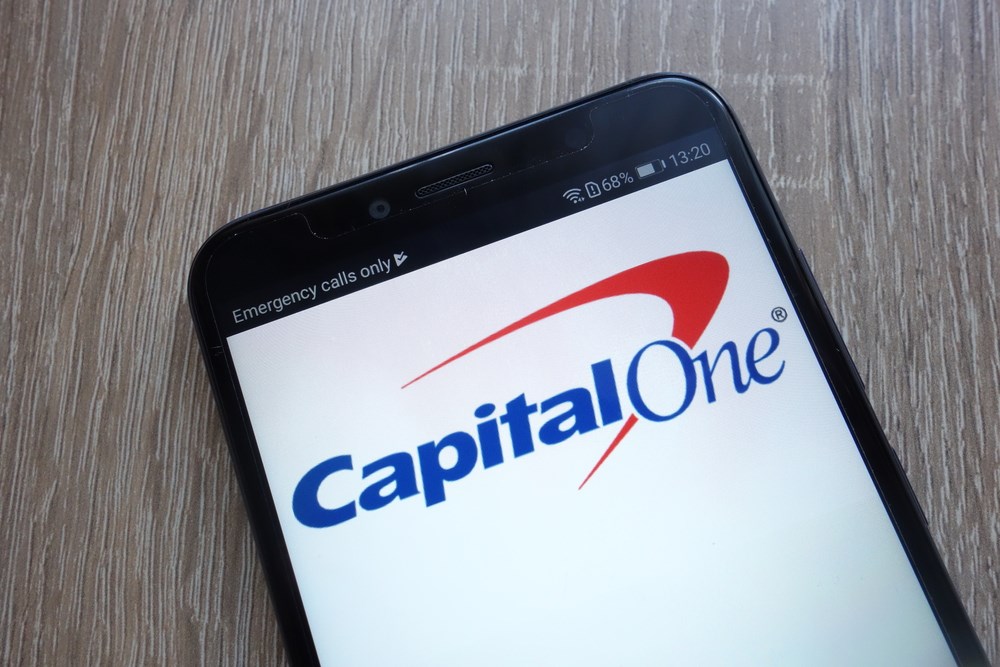
Inflation and high interest rates are leaving less money in American wallets…but more money at some U.S. banks, including Capital One Financial Corporation (NYSE: COF).
The company’s recently reported third-quarter results reveal that consumers continue to carry high revolving loan and credit card balances as they struggle to keep up with rising prices and rates. At the same time, fewer consumers are defaulting on their financial obligations, with inflation pressures easing and wage growth improving. While less than an ideal scenario for cash-strapped households, the unusual combination of high credit card rates and fewer net charge-offs is proving to be a positive backdrop for Capital One.
The company’s third-quarter earnings per share (EPS) of $4.45 not only trounced Wall Street’s estimate by more than $1.00 but also marked the company’s first year-over-year profit growth since the fourth quarter of 2021. With revenue also up 6% to roughly $9.4 billion and credit costs stabilizing, investors have begun positioning for a potential pivot point.
Capital One shares gapped up in two-times normal volume following the October 26th third-quarter report and haven’t looked back since. They have bounced more than 20% off their pre-release low — and, given their low valuation, may have a long way to go.
Is Capital One stock undervalued?
Capital One is currently trading at 8x trailing 12 months earnings. The average price-to-earnings (P/E) ratio within the consumer finance industry is approximately 11x. This means that 1) Capital One is trading at a considerable discount to its peer group, and 2) P/E multiple expansion to the industry average could involve more than 30% share price appreciation.
Revised analyst price targets suggest that a 30% rally on top of the recent bounce is fathomable. Robert W. Baird responded to the Q3 results by reiterating its buy rating and setting a $140 price target, which is about 30% upside from Friday’s close. KBW matched the bullish sentiment and offered a $145 target.
Not everyone is convinced, however, that Capital One is out of the woods when it comes to sustainable profit growth. Despite the strong report, several firms maintained hold ratings — including Oppenheimer, which lauded the $2.1 million drop in credit loss provisions but kept a neutral stance.
With Morgan Stanley’s sell call an exception, the response to the Q3 report has been a mix of bull riders and fence riders. This could make the fourth quarter earnings report a pivotal moment for a stock trying to claw its way back to an August 2021 record high of $177.95. The consensus estimate for fourth-quarter EPS growth is -1%. If management can deliver a second straight profit growth surprise, the credibility of the turnaround story should go up.
What may be even more important than following up the Q3 beat with a strong Q4 performance is an upbeat 2024 outlook. CEO Richard Fairbank touted “strong top-line growth” in the domestic credit card business, but it's the commercial lending side of the business that could be a sneaky source of outperformance. If construction companies and other interest rate-dependent businesses start to see improved homebuilding and renovation activity, demand for commercial loans could become a catalyst for 2024.
Next year, Capital One is forecast to generate EPS of $13.72. This gives the stock a 7.7x forward P/E. Fellow S&P 500 consumer finance company American Express goes for 12x next year’s earnings. Although AXP deserves a premium for its higher exposure to corporate travel, the valuation gap has Capital One looking like a good way to invest in a consumer spending rebound.
Does Capital One pay a dividend?
Another thing to like about Capital One is the dividend. The stock pays a $0.60 per share dividend quarterly, or $2.40 annually, which equates to a 2.3% yield. If U.S. Treasury yields continue to decline, a reduced gap between dividend-paying companies and bonds could make income stocks like COF more attractive.
Again, comparing COF to larger peer AXP, the latter has a lower dividend yield (1.6%) as well as a slightly weaker dividend coverage ratio (5.3x for AXP vs 5.7x for COF) based on next year’s projected earnings.
Given the improving fundamentals, low P/E ratio and above-S&P 500 dividend yield, Capital One looks like a smooth large-cap value play. The only thing smoother is the tone of spokesman Samuel Jackson’s “What’s in your wallet?”












